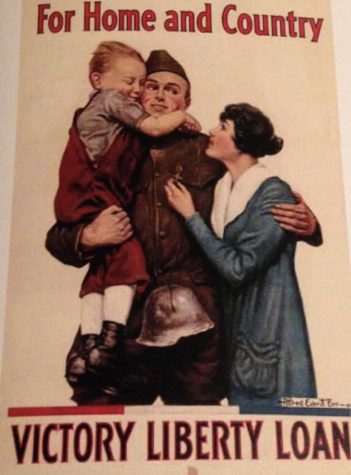WWI Exhibit Visits WPU
September 25, 2017
“I WANT YOU!”
That famous picture of Uncle Sam pointing his finger at the viewer is an iconic American image. His stern face staring intensely at you. The simplicity of the image hides a complex meaning that has to be interpreted thoroughly to be understood. The power of the emotional appeal is the driving force of propaganda. And today, it is not completely obvious to us what propaganda is and what is not.
The Ben Shahn Center for the Visual Arts is hosting an exhibit to commemorate the centennial of the First World War. Twenty-six posters are on display on loan from the Newark Public Library. The Visual Arts building is behind the Science Complex. The Exhibit is in the South Gallery, on the right at the entrance. It will run until the end of the fall semester and was organized by Professor Robb, a History Professor at William Paterson, with help from graduate students.
World War I is a war often overlooked in the American psyche. It does not hold the same symbolic value as wars such as the Civil War and World War II. While those wars were about ending slavery and defeating Fascism, World War I does not have a clear message associated it. President Woodrow Wilson described the war as “A War to End all Wars,” but as we know, wars have continued undeterred since.
Why should college students go see this exhibit?
This exhibit is not only for history majors or people who are interested in World War I; it is suitable for everyone because it shows a form of communication that is widespread today. During the war, these posters were used as propaganda by the United States government to sustain morale and approval for the war effort. This gallery conveys the power and sway images can have on the individual.
This is the birth of large scale propaganda in American culture. The beginning of a mass media culture. Radio, Television, and the Internet bombard individuals with advertisements. During the early twentieth century it was seen as a sign of disgrace to wear someone’sname on your shirt. Today, it is commonplace: Nike™, Adidas™, Hollister™, Apple™ and many more.

Do these images still hold weight today?
Professor Robb says, “Some of the art and imagery in this exhibit may appear quaint and old fashioned just as the poster as a medium of communication seems technologically primitive in the internet age. Nevertheless, the wartime poster campaign marks the beginning of a modern American visual style and political culture. Propaganda has not gone away, however much we might condemn it. Commercial and political advertising has become bolder, more outrageous and psychologically manipulative, building on the style and techniques of wartime image makers. World War I inaugurated a new culture saturated with startling images, colorful advertisements, and calls to action.”
Although these posters are not the gifs or memes that one sees today on online forums, they hold the same meaning as their forerunners: as a means of pushing information, true and untrue, logical and illogical, onto a malleable population. Understanding the essence of something and where it comes from is an important part of life. All too often, misinformation can creep into the public sphere and change public opinion.
The gallery hours are 10:00 a.m. – 5:00 p.m., Monday – Friday.